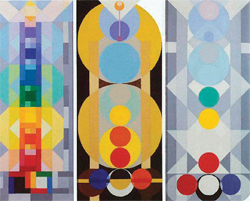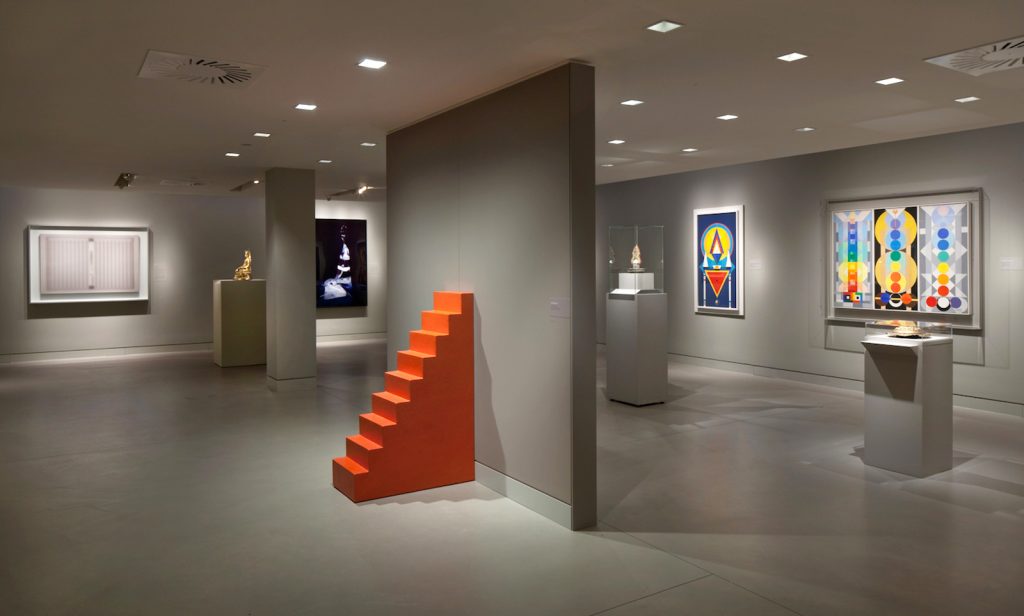The concept of emptiness (Sanskrit, shunyata)—the principle that all created phenomena lack independent existence—is one of the central tenets of Buddhism. It is also one of the most complex: from it may be unpacked closely related ideas about impermanence, interconnectedness, and the illusory nature of ordinary reality—notions that can also be found in the work of the five artists featured in “Grain of Emptiness: Buddhism-Inspired Contemporary Art,” at the Rubin Museum of Art in New York City.
The belief that nonobjective painting could convey a vision of true reality underpins the work of Charmion von Wiegand (1896–1983), a friend and follower of Piet Mondrian. Included in the show are her geometric abstractions of the 1960s, which borrowed equally from European neoplasticism and Tibetan ritual art. In some cases, these works are paired with objects from the museum’s collection, for example, The Chakras(1958– 68), a jazzy, modernist version of a body mandala whose interlocking triangles are echoed in a nearby bronze Nepalese yantra.
Impermanence is graphically illustrated in two time-lapse photographs by Atta Kim, whose work otherwise seems facile. In pictures shot over eight hours in New Delhi and in New York’s Times Square, street traffic is an almost invisible blur, emphasizing the transience of the lives and doings we find so persuasively concrete.
The doctrine of shunyata does not question the truth of existence, but rather the manner in which we perceive it. How we construct our reality through descriptions and labels is a central theme in the work of the multimedia artist Theaster Gates. The term shunyata is also sometimes translated as “openness,” and it is this aspect of emptiness that can be found in “Breathing,” Gates’s video of the Black Monks of Mississippi, a performance group that blends syncopated Buddhist chanting with gospel-inspired vocals, blurring the distinction between Buddhist and Christian practice.
 Great compassion, according to Shantideva, is impossible without an understanding of emptiness—and the consequent realization that there is no “self ” that exists apart from a constantly changing, contingent, and interdependent universe. A spectacular 15th-century thankga depicting Avalokiteshvara, the Bodhisattva of Compassion, presides over Wolfgang Laib’s red granite “rice house” smeared with red ghee, a square marble basin filled daily with a libation of fresh milk, and brass plates heaped with “meals” of rice and pollen. As if to underscore the equivalence of peaceful and wrathful compassionate action, the room also features a 19th-century Chinese embroidery showing a fearsome offering—in the form of a body being boiled in a skull cup—to the protector Mahakala.
Great compassion, according to Shantideva, is impossible without an understanding of emptiness—and the consequent realization that there is no “self ” that exists apart from a constantly changing, contingent, and interdependent universe. A spectacular 15th-century thankga depicting Avalokiteshvara, the Bodhisattva of Compassion, presides over Wolfgang Laib’s red granite “rice house” smeared with red ghee, a square marble basin filled daily with a libation of fresh milk, and brass plates heaped with “meals” of rice and pollen. As if to underscore the equivalence of peaceful and wrathful compassionate action, the room also features a 19th-century Chinese embroidery showing a fearsome offering—in the form of a body being boiled in a skull cup—to the protector Mahakala.
Like von Wiegand, Sanford Biggers often repurposes Buddhist iconography in his work. For this exhibition he has created an enormous disc made of glass, its surface etched with an image of a lotus—a potent symbol of transmutation in Buddhist art. Each petal of the lotus is a copy of the infamous Brookes diagram, depicting the stowage of the Liverpool slave ship Brookes and the chillingly scientific packing of its human cargo. A symbol of the horrors of the Middle Passage, it is also a symbol of the compassion of its creators, campaigners for the abolition of the transatlantic slave trade, and thus, likewise an icon of transformation.
Interestingly, none of the artists in “Grain of Emptiness” identify themselves as practicing Buddhists. That they should nevertheless find durable themes in Buddhist philosophy seems proof of its continued—and even, in an increasingly interconnected world, particular—relevance to modern life.
Thank you for subscribing to Tricycle! As a nonprofit, we depend on readers like you to keep Buddhist teachings and practices widely available.
